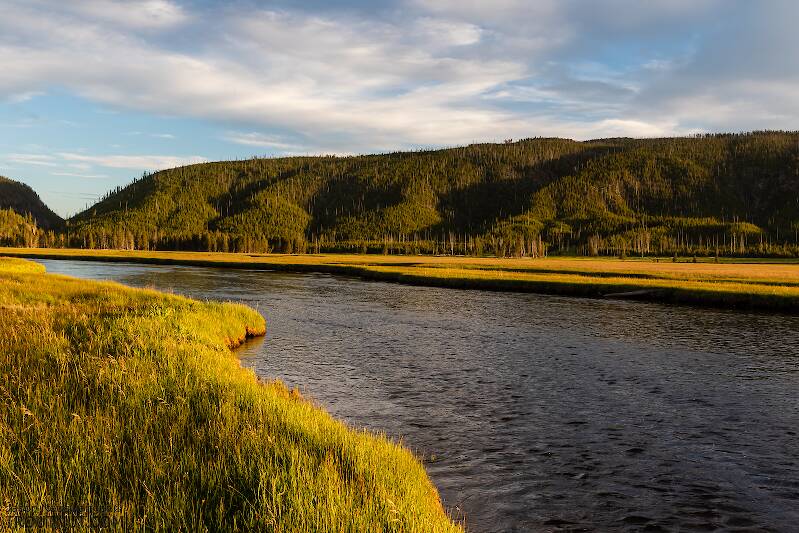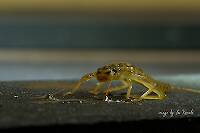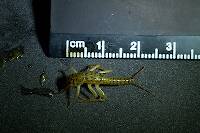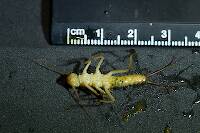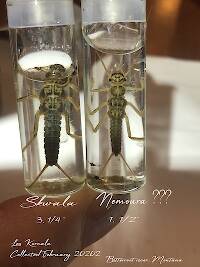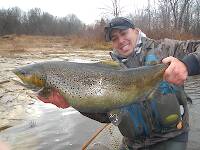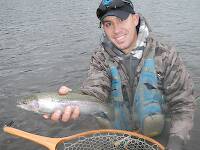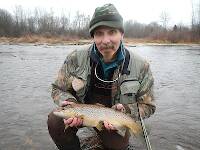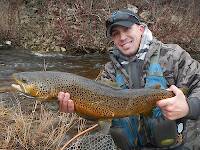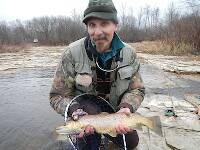
Blue-winged Olives
Baetis
Tiny Baetis mayflies are perhaps the most commonly encountered and imitated by anglers on all American trout streams due to their great abundance, widespread distribution, and trout-friendly emergence habits.
Featured on the forum

Troutnut is a project started in 2003 by salmonid ecologist Jason "Troutnut" Neuswanger to help anglers and
fly tyers unabashedly embrace the entomological side of the sport. Learn more about Troutnut or
support the project for an enhanced experience here.
Troutnut on May 18, 2007May 18th, 2007, 2:32 pm EDT
I just got caught up with all the specimens I've been photographing but haven't had time to put up on the site yet. I really don't have time to ID all the interesting ones I don't immediately recognize (so much to do right now!) so please take a crack at IDing them if you want.
Since they won't all fit in my 'recent updates' panel (which is in for a big overhaul) here are the links:
http://www.troutnut.com/specimen/691 - Epeorus nymph, probably pleuralis.
http://www.troutnut.com/specimen/692 - Definitely Ameletus ludens.
http://www.troutnut.com/specimen/693 - Paraleptophlebia nymph.
http://www.troutnut.com/specimen/694 - Baetis nymph, probably tricaudatus but it's hard to tell.
http://www.troutnut.com/specimen/695 - Ameletus nymph, it's a pretty early instar, but its markings are quite different from my other ludens specimens, so it might be a different species.
http://www.troutnut.com/specimen/696 - Eurylophella nymph.
http://www.troutnut.com/specimen/697 - Ephemerella aurivillii nymph. At least I'm pretty sure that's what it is.
http://www.troutnut.com/specimen/698 - Stenonema femoratum nymph. My first genuine Stenonema, not Maccaffertium.
http://www.troutnut.com/specimen/699 - Paragnetina stonefly. This one's really pretty. Anyone recognize which species?
http://www.troutnut.com/specimen/700 - Sculpin. It looks strange compared to most sculpins I've found in trout streams. Anyone know which species?
http://www.troutnut.com/specimen/701 - Rhyacophila pupa in cocoon.
http://www.troutnut.com/specimen/702 - Rhyacophila larva. This "green rockworm" is actually tan.
http://www.troutnut.com/specimen/703 - Very small cased caddis larva of unknown family.
http://www.troutnut.com/specimen/704 - Brachycentridae caddis pupa.
http://www.troutnut.com/specimen/705 - Hydropsychidae caddis larva. Anyone know the genus?
http://www.troutnut.com/specimen/706 - Cool, green midge.
http://www.troutnut.com/specimen/707 - A vividly yellow and black stonefly adult. I'm guessing Perlidae but I would love a more detailed ID.
http://www.troutnut.com/specimen/708 - A pretty large Epeorus male spinner. It seems a bit late in the year for pleuralis, but this was a very small headwater, so that could be it.
http://www.troutnut.com/specimen/709 - Male Paraleptophlebia spinner.
http://www.troutnut.com/specimen/710 - Female Leptophlebia dun, either cupida or nebulosa.
http://www.troutnut.com/specimen/711 - Same as above, but a spinner.
http://www.troutnut.com/specimen/712 - Female Ephemera varia dun (yellow drake) that hatched out of my aquarium.
http://www.troutnut.com/specimen/713 - Apple caddis (Brachycentrus appalachia) adult.
http://www.troutnut.com/specimen/714 - A strange little adult caddis. Don't know the ID, but it seems similar to specimen 728.
http://www.troutnut.com/specimen/715 - Apple caddis (Brachycentrus appalachia) pupa. I'm just guessing the ID based on the fact that so many adults of that species are emerging around the collection site right now, and the color fits.
http://www.troutnut.com/specimen/716 - Ephemerella septentrionalis nymph. This is a really cool species.
http://www.troutnut.com/specimen/717 - Siphlonurus quebecensis nymph, mid-molt.
http://www.troutnut.com/specimen/718 - Regular Siphlonurus quebecensis nymph.
http://www.troutnut.com/specimen/719 - Another Ephemerella septentrionalis nymph in a different color variation.
http://www.troutnut.com/specimen/720 - Rhyacophila caddis larva.
http://www.troutnut.com/specimen/721 - Unidentified cased caddis larvae.
http://www.troutnut.com/specimen/722 - Allocapnia stonefly nymph, I think. I tried to follow the key in Merrit & Cummins throgh my pictures but the pictures weren't ideal in a few spots so I could have made a mistake.
http://www.troutnut.com/specimen/723 - Little yellow stonefly adult, just guessing Chloroperlidae.
http://www.troutnut.com/specimen/724 - Male Epeorus spinner, of a small, light species.
http://www.troutnut.com/specimen/725 - Female Epeorus dun, probably same species as the male above.
http://www.troutnut.com/specimen/726 - A really photogenic big caddisfly adult. Based on general appearance I'm guessing Hydropsychidae, but I would really like a more confident ID. This was one of the main bugs the fish were taking the other day on the West Branch of the Delaware.
http://www.troutnut.com/specimen/727 - Apple caddis (Brachycentrus appalachia) adult.
http://www.troutnut.com/specimen/728 - Unknown caddis adult, similar to specimen 714, but with different markings.
http://www.troutnut.com/specimen/729 - Male Epeorus dun.
I think specimens 724, 725, and 729 may all be Epeorus vitreus, but I have no solid information on how to ID that species, just vague descriptions. The only dichotomous key I have for Epeorus is from the 1930s for the ex-genus Iron and it doesn't include vitreus. Does anyone know how to ID it definitively?
If you have some ID insights on one of the bugs, please add it to a topic (or create one) on the specimen page, rather than putting it in a reply here. Thanks!
Since they won't all fit in my 'recent updates' panel (which is in for a big overhaul) here are the links:
http://www.troutnut.com/specimen/691 - Epeorus nymph, probably pleuralis.
http://www.troutnut.com/specimen/692 - Definitely Ameletus ludens.
http://www.troutnut.com/specimen/693 - Paraleptophlebia nymph.
http://www.troutnut.com/specimen/694 - Baetis nymph, probably tricaudatus but it's hard to tell.
http://www.troutnut.com/specimen/695 - Ameletus nymph, it's a pretty early instar, but its markings are quite different from my other ludens specimens, so it might be a different species.
http://www.troutnut.com/specimen/696 - Eurylophella nymph.
http://www.troutnut.com/specimen/697 - Ephemerella aurivillii nymph. At least I'm pretty sure that's what it is.
http://www.troutnut.com/specimen/698 - Stenonema femoratum nymph. My first genuine Stenonema, not Maccaffertium.
http://www.troutnut.com/specimen/699 - Paragnetina stonefly. This one's really pretty. Anyone recognize which species?
http://www.troutnut.com/specimen/700 - Sculpin. It looks strange compared to most sculpins I've found in trout streams. Anyone know which species?
http://www.troutnut.com/specimen/701 - Rhyacophila pupa in cocoon.
http://www.troutnut.com/specimen/702 - Rhyacophila larva. This "green rockworm" is actually tan.
http://www.troutnut.com/specimen/703 - Very small cased caddis larva of unknown family.
http://www.troutnut.com/specimen/704 - Brachycentridae caddis pupa.
http://www.troutnut.com/specimen/705 - Hydropsychidae caddis larva. Anyone know the genus?
http://www.troutnut.com/specimen/706 - Cool, green midge.
http://www.troutnut.com/specimen/707 - A vividly yellow and black stonefly adult. I'm guessing Perlidae but I would love a more detailed ID.
http://www.troutnut.com/specimen/708 - A pretty large Epeorus male spinner. It seems a bit late in the year for pleuralis, but this was a very small headwater, so that could be it.
http://www.troutnut.com/specimen/709 - Male Paraleptophlebia spinner.
http://www.troutnut.com/specimen/710 - Female Leptophlebia dun, either cupida or nebulosa.
http://www.troutnut.com/specimen/711 - Same as above, but a spinner.
http://www.troutnut.com/specimen/712 - Female Ephemera varia dun (yellow drake) that hatched out of my aquarium.
http://www.troutnut.com/specimen/713 - Apple caddis (Brachycentrus appalachia) adult.
http://www.troutnut.com/specimen/714 - A strange little adult caddis. Don't know the ID, but it seems similar to specimen 728.
http://www.troutnut.com/specimen/715 - Apple caddis (Brachycentrus appalachia) pupa. I'm just guessing the ID based on the fact that so many adults of that species are emerging around the collection site right now, and the color fits.
http://www.troutnut.com/specimen/716 - Ephemerella septentrionalis nymph. This is a really cool species.
http://www.troutnut.com/specimen/717 - Siphlonurus quebecensis nymph, mid-molt.
http://www.troutnut.com/specimen/718 - Regular Siphlonurus quebecensis nymph.
http://www.troutnut.com/specimen/719 - Another Ephemerella septentrionalis nymph in a different color variation.
http://www.troutnut.com/specimen/720 - Rhyacophila caddis larva.
http://www.troutnut.com/specimen/721 - Unidentified cased caddis larvae.
http://www.troutnut.com/specimen/722 - Allocapnia stonefly nymph, I think. I tried to follow the key in Merrit & Cummins throgh my pictures but the pictures weren't ideal in a few spots so I could have made a mistake.
http://www.troutnut.com/specimen/723 - Little yellow stonefly adult, just guessing Chloroperlidae.
http://www.troutnut.com/specimen/724 - Male Epeorus spinner, of a small, light species.
http://www.troutnut.com/specimen/725 - Female Epeorus dun, probably same species as the male above.
http://www.troutnut.com/specimen/726 - A really photogenic big caddisfly adult. Based on general appearance I'm guessing Hydropsychidae, but I would really like a more confident ID. This was one of the main bugs the fish were taking the other day on the West Branch of the Delaware.
http://www.troutnut.com/specimen/727 - Apple caddis (Brachycentrus appalachia) adult.
http://www.troutnut.com/specimen/728 - Unknown caddis adult, similar to specimen 714, but with different markings.
http://www.troutnut.com/specimen/729 - Male Epeorus dun.
I think specimens 724, 725, and 729 may all be Epeorus vitreus, but I have no solid information on how to ID that species, just vague descriptions. The only dichotomous key I have for Epeorus is from the 1930s for the ex-genus Iron and it doesn't include vitreus. Does anyone know how to ID it definitively?
If you have some ID insights on one of the bugs, please add it to a topic (or create one) on the specimen page, rather than putting it in a reply here. Thanks!
Jason Neuswanger, Ph.D.
Troutnut and salmonid ecologist
Troutnut and salmonid ecologist
Quick Reply
Related Discussions
Topic
Replies
Last Reply
2
Feb 24, 2020
by Leskorcala
by Leskorcala
8
Jun 5, 2007
by Dinerobyn
by Dinerobyn
1
Oct 28, 2008
by GONZO
by GONZO
0
Jul 10, 2006
by Troutnut
by Troutnut
3
Jul 22, 2014
by Entoman
by Entoman

